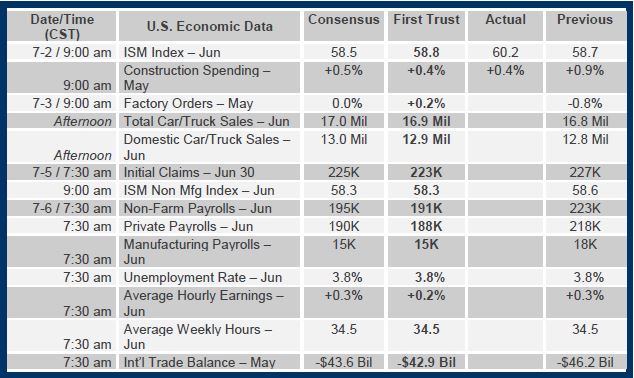Brian Wesbury Weekly Outlook
03.07.2018 15:40 - First Trust Global Portfolios Limited

Election Outlook (02 July 2018)
At least three reasons suggest the Democrats should be optimistic about taking control of the House this November.
First, the party controlling the White House typically loses seats in mid-terms. These include “tidal waves” against the president’s party like in 1994 and 2010, when newly-elected presidents Bill Clinton and Barack Obama watched their parties lose 54 and 63 seats, respectively. Yes, 2002 was an exception, when the GOP gained 8 seats under President Bush. But that was after 9/11 when the nation was focused on national security, where the GOP had a significant advantage.
The second is the number of House Republicans who have announced retirements since the last election – 40+ at last count. Some read this as a sign of low confidence in retaining control.
The third reason is that in special congressional elections in 2017-18, Democrats have typically outperformed by about 16 percentage points compared to what they normally do.
Yet the President’s job approval rating has improved this year. Last December, his approval was at an all-time low of 37%; now it’s above 43%.
The last time the Democrats won the House from the GOP was in 2006. Back then, in early July, they were winning in the “generic ballot” (the poll that asks which party you’d rather control the House) by 12 points; now they’re winning by about 6 points. In other words, 2006 this is not, at least not yet.
It still looks like the Democrats are going to pick up some seats in the House, but it also looks like the Blue Wave crested early, so a tidal wave is unlikely. Instead, it looks like it will go down to the wire, and we give the Republicans a very slight edge, although we wouldn’t be shocked by a narrow Democratic victory, either. It’s even possible the GOP loses but a handful of seats.
Meanwhile, Republicans are in good shape in the Senate. Currently, the GOP has a slight 51-49 edge over the Democrats. But, of the 35 Senate seats contested in November, the Democrats already occupy 26, while Republicans have only 9, giving the Democrats few opportunities to make gains.
Even worse for the Democrats is having five incumbents running in states Trump easily won by double-digit margins. By contrast, the only vulnerable Republican seats are in Nevada, which Trump lost by just 2 points, Arizona, where he won by 3.5 points, and Tennessee, where he won by 26 points. As a result, we think the Republicans will probably gain two seats in the Senate this year.
If we’re right, with one party narrowly controlling the House and the GOP enlarging their majority in the Senate, it will be a tougher legislative environment for the president. But the Senate controls appointments to the Courts and agencies and, as long as the president can keep his own party in-line, he will have broad discretion to pick who he wants.
This means the deregulatory agenda stays on track, which will be a tailwind for equity investors and the economy in the next two years. At the same time, tax cuts won’t be repealed and there is little change to the outlook for spending, either pro or con. The political environment is changing, but the investing environment remains positive.
Brian S. Wesbury - Chief Economist
Robert Stein, CFA – Deputy Chief Economist
